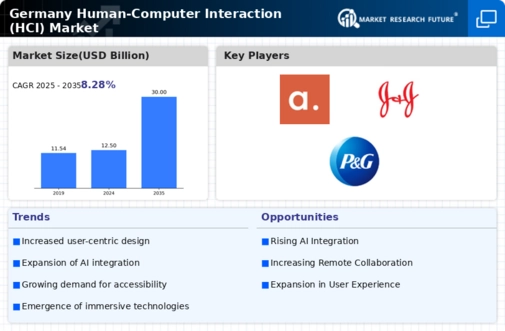Germany Human-Computer Interaction (HCI) is undergoing notable changes, mostly due to user-centered design principles and technology breakthroughs. There is a noticeable trend toward more user-friendly interfaces as sectors aim for increased productivity and engagement. The growing usage of mobile and smart devices is driving this trend, which has a big impact on industries like healthcare, education, and the automotive industry. Under the "Digital Strategy 2025," in particular, the German government has launched a number of efforts to encourage digital innovation, creating an atmosphere that is favorable for advancements in HCI.
As customer tastes evolve toward seamless engagement experiences, businesses concentrating on voice interfaces and AI-powered solutions have a lot of opportunities.
The need for improved HCI designs that accommodate a range of user demographics, representing Germany's diverse population, has also increased due to the growth of remote work and digital communication platforms. There is increasing interest in creating more secure HCI systems that comply with strict German legislation, with a focus on user security and data privacy. Recent developments show how augmented reality (AR) and virtual reality (VR) are increasingly being used to create immersive experiences, particularly in fields like instruction and entertainment.
In addition, accessibility is emphasized significantly to guarantee that HCI solutions accommodate people with disabilities, demonstrating Germany's dedication to inclusivity.The interaction of these elements reveals a dynamic environment in the German HCI market, where user experience and innovation are leading the way.
Germany Human-Computer Interaction (HCI) Market Drivers
Rising Demand for Enhanced User Experience
The growing emphasis on improving user experience across various sectors is a significant driver of growth in the Germany Human-Computer Interaction (HCI) Market Industry. As organizations increasingly recognize the importance of user-centric design, investments in Research and Development are ramping up. For instance, in Germany, the Federal Ministry for Economic Affairs and Energy has initiated several funding programs aiming to promote innovation in user experience design, with an investment of over 300 million Euros in recent years.
This initiative has led to an increase in collaborations between tech startups and established firms, such as Siemens AG and SAP SE, driving the development of advanced HCI solutions that cater to the needs of diverse user groups. Therefore, the synergy of government support and private sector investments is pivotal in enhancing user experience technologies in Germany.
Integration of Artificial Intelligence in HCI
The integration of Artificial Intelligence (AI) technologies into Human-Computer Interaction systems is another key driver shaping the Germany Human-Computer Interaction (HCI) Market Industry. According to a report by the German Federal Government, AI-related businesses in Germany saw a staggering growth rate of 26% in investments between 2020 and 2021, totaling approximately 1.6 billion Euros.
This rapid growth fosters innovations in voice recognition, facial recognition, and personalized user interfaces.Established companies, such as Bosch and Deutsche Telekom, are actively enhancing their HCI offerings through AI, providing German consumers with more efficient and customized interactions with technology. This trend reflects the increasing demand for AI-enhanced solutions that improve usability and accessibility, thus expediting market growth.
Expansion of Virtual and Augmented Reality Applications
The expansion of Virtual Reality (VR) and Augmented Reality (AR) technologies is significantly influencing the Germany Human-Computer Interaction (HCI) Market Industry. The German Federal Ministry of Transport and Digital Infrastructure has reported a 40% increase in the adoption of VR and AR technologies across different sectors, including education, healthcare, and entertainment, since 2019. This growth is attributed to major investments from organizations like Unity Technologies and Fraunhofer Society, which are leading the charge in developing immersive HCI experiences.
Moreover, the German government has pledged substantial funding to support innovative projects that leverage VR and AR for training and education, demonstrating a commitment to integrate these technologies into everyday applications. The rise of these immersive technologies signifies a shift in user interaction paradigms, necessitating advancements in HCI designs to accommodate such interactive environments.
Germany Human-Computer Interaction (HCI) Market














Leave a Comment